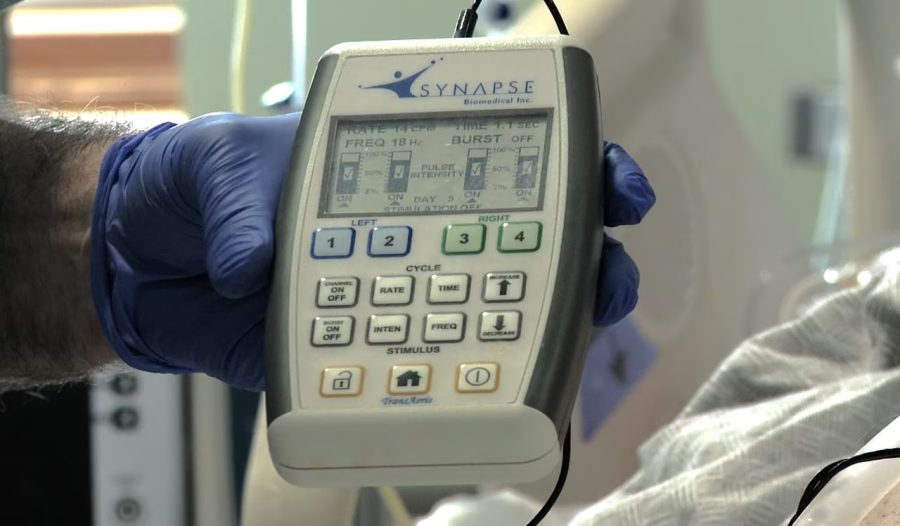Oberlin Company Receives FDA Approval for Diaphragm Pacing System
NeuRX DPS allows spinal cord patients to breathe without a ventilator.
Synapse Biomedical, an Oberlin based biotechnology company, received FDA premarket approval on April 5 for the NeuRX Diaphragm Pacing System.
“Approval for the NeuRx DPS® is intended for use in patients with stable, high spinal cord injuries with stimulatable diaphragms, but who lack control of their diaphragms,” the FDA’s Approval Order Statement reads. “The device is indicated to allow the patients to breathe without the assistance of a mechanical ventilator for at least four continuous hours a day. Its use is only in patients 18 years of age or older.”
The system works by using electrodes to stimulate the paralyzed diaphragm, causing it to contract and allowing the patient to breathe. Dr. Raymond Onders, one of the main project leaders, noted that in certain cases, the electrodes can eventually be removed when the nerves regain function.
“We have very good evidence now of what we call the trophic effect of electrostimulation, and we stimulate the diaphragm and there’s an afferent effect to the nerve that changes the spinal cord milieu,” Onders said.
The system was designed by Professor Emeritus J. Thomas Mortimer of Case Western Reserve University in Cleveland. Mortimer said that he developed an interest in electrical stimulation after a childhood friend was paralyzed in an automotive accident. Mortimer later recruited Onders when he was a resident to help recruit patients for human trials at the suggestion of Dr. Tom Stellato, another doctor with whom he was working on the project. According to Synapse CEO Anthony Ignagni, the device has helped 2,500 people in over 30 countries including Japan, Canada, Australia, the U.S., and others in Europe and the Middle East.
“We’ve completed mapping 11 patients,” Mortimer said. “Tom Stellato says to me ‘I don’t know [what] Ray’s telling these people. He recruited 10 and I was only able to recruit one.’ … Dr. Onders was a critical force in getting this into the place where it is now where it’s a commercial product,”
According to Onders, the DPS was previously approved under Humanitarian Device Exemption Approval, which it received in 2007. He explained that the HDE approval severely limited the number of hospitals at which the device could be used. In order for a device with a HDE approval to be used at a given hospital, it must be greenlit by the hospital’s institutional review board.
“Under this program, there’s a 1988 FDA rule that requires somebody to have an IRB approval to do it, even though it’s not research,” Onders said.
Additionally, Ignani wrote in an email to the Review that the IRB would have to review the data each year, not just as a one-off occurrence, a time consuming process.
“If you’re injured in Iowa or someplace and you don’t have a hospital that’s already doing it, it’s very difficult to transfer,” Onders said.
Onders noted that the COVID-19 pandemic introduced a broader need for the device given a shortage of ventilators.
“So year 2020, roughly, that’s when we started realizing we needed to have improved access,” Onders said. “The COVID pandemic started highlighting that also. … We can help get anybody off the ventilator earlier, and that’s very important when you reach a shortage of ventilators.”
The premarket approval removes the IRB requirement, meaning that any hospital in the country can now use the device. While currently only approved for patients over the age of 18, the device has shown preliminary success with much younger patients.
“I’ve actually implanted NICU babies,” Onders said. “We [also] just implanted a very unfortunate one year old at our hospital within four weeks of her injury.”
Synapse Biomedical was officially founded in Oberlin in 2002 to commercialize the NeuRx DPS. Mortimer and Ignagni chose Oberlin because they were able to find an old seed factory to operate out of without having to pay rent. Onders noted that because agricultural operations are subject to FDA requirements, the seed factory was up to the standard they would need for biotech. Synapse currently employs 29 people out of its office in Oberlin and may expand its operations.
“As we grow our business we will continue to add to our staff in that facility,” Ignagni wrote. “We currently have sufficient people to build our forecasted needs, but certainly know that we will need to add in the future.”
Onders noted that in addition to the NeuRX DPS, Synapse is working on securing approval for a device for stroke patients.


